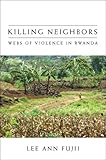Killing Neighbors : Webs of Violence in Rwanda / Lee Ann Fujii.
Material type: TextPublisher: Ithaca, NY : Cornell University Press, [2010]Copyright date: ©2011Description: 1 online resource (224 p.) : 2 tables, 1 map, 2 line drawings, 3 halftonesContent type:
TextPublisher: Ithaca, NY : Cornell University Press, [2010]Copyright date: ©2011Description: 1 online resource (224 p.) : 2 tables, 1 map, 2 line drawings, 3 halftonesContent type: - 9780801458613
- Ethnic conflict -- Rwanda
- Ethnic conflict -- Rwanda
- Genocide -- Rwanda
- Genocide -- Rwanda
- Political violence -- Rwanda
- Political violence -- Rwanda
- Violence -- Rwanda
- Violence -- Rwanda
- African Hist & Diaspora
- History
- Political Science & Political History
- POLITICAL SCIENCE / Genocide & War Crimes
- African Studies
- Hutu
- Rwanda
- Rwandan genocide
- Tutsi
- african anthropology
- african ethnic relations
- african history
- african politics
- civil violence
- ethnic relations
- ethnicity studies
- genocide studies
- genocide
- hutu killed
- killing kith
- literature on the Rwandan genocide
- power politics
- race studies
- rwandan genocide
- rwandan history
- the order of genocide
- understanding genocide
- violence in Rwanda
- violence in society
- violence studies
- 967.57104/2 22/eng/20231120
- online - DeGruyter
| Item type | Current library | Call number | URL | Status | Notes | Barcode | |
|---|---|---|---|---|---|---|---|
 eBook
eBook
|
Biblioteca "Angelicum" Pont. Univ. S.Tommaso d'Aquino Nuvola online | online - DeGruyter (Browse shelf(Opens below)) | Online access | Not for loan (Accesso limitato) | Accesso per gli utenti autorizzati / Access for authorized users | (dgr)9780801458613 |
Frontmatter -- Contents -- Acknowledgments -- Abbreviations -- Introduction: Genocide among Neighbors -- 1. Conducting Fieldwork in the Aftermath of War and Genocide -- 2. Violence and Identity in Historical Perspective -- 3. Local Narratives and Explanations -- 4. The Enigma of Ethnicity -- 5. The Power of Local Ties -- 6. The Logic of Groups -- Conclusion -- Dramatis personae -- Glossary of Kinyarwanda Terms -- References -- Index
restricted access online access with authorization star
http://purl.org/coar/access_right/c_16ec
In the horrific events of the mid-1990s in Rwanda, tens of thousands of Hutu killed their Tutsi friends, neighbors, even family members. That ghastly violence has overshadowed a fact almost as noteworthy: that hundreds of thousands of Hutu killed no one. In a transformative revisiting of the motives behind and specific contexts surrounding the Rwandan genocide, Lee Ann Fujii focuses on individual actions rather than sweeping categories.Fujii argues that ethnic hatred and fear do not satisfactorily explain the mobilization of Rwandans one against another. Fujii's extensive interviews in Rwandan prisons and two rural communities form the basis for her claim that mass participation in the genocide was not the result of ethnic antagonisms. Rather, the social context of action was critical. Strong group dynamics and established local ties shaped patterns of recruitment for and participation in the genocide.This web of social interactions bound people to power holders and killing groups. People joined and continued to participate in the genocide over time, Fujii shows, because killing in large groups conferred identity on those who acted destructively. The perpetrators of the genocide produced new groups centered on destroying prior bonds by killing kith and kin.
Mode of access: Internet via World Wide Web.
In English.
Description based on online resource; title from PDF title page (publisher's Web site, viewed 26. Apr 2024)


